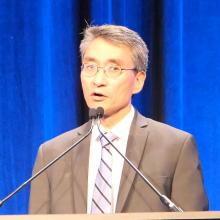SAN ANTONIO – An investigational muco-adherent swallowed formulation of budesonide developed specifically for treatment of eosinophilic esophagitis aced all primary and secondary endpoints in a pivotal, phase 3, double-blind, placebo-controlled randomized trial, Ikuo Hirano, MD, reported at the annual scientific meeting of the American College of Gastroenterology.
This is welcome news for patients with this chronic immune-mediated disease, for which no Food and Drug Administration–approved drug therapy exists yet.
“This is the first phase 3 trial to demonstrate efficacy using the validated Dysphagia Symptom Questionnaire, the first completed phase 3 trial of any medical therapeutic for eosinophilic esophagitis, and the largest clinical trial for eosinophilic esophagitis conducted to date,” declared Dr. Hirano, professor of medicine at Northwestern University in Chicago.
This was a 12-week induction therapy study including 318 adolescents and adults randomized 2:1 to 2 mg of budesonide oral suspension (BOS) or placebo twice daily. Patients were instructed not to eat or drink anything for 30 minutes afterward to avoid washing away the medication.
This was a severely affected patient population with high-level inflammatory activity: their mean baseline peak eosinophil count was 75 cells per high-power field, well above the diagnostic threshold of 50 eosinophils per high-power field. In keeping with a requirement for study participation, all patients had failed to respond to at least 6 weeks of high-dose proton pump inhibitor therapy. They also had to experience solid food dysphagia on at least 4 days per 2 weeks. More than 40% of subjects had previously undergone esophageal dilation.
One coprimary endpoint addressed histologic response, defined as 6 or fewer eosinophils per high-power field after 12 weeks of double-blind treatment. The histologic response rate was 53% in the BOS group and 1% in placebo-treated controls.
The other coprimary endpoint was symptom response as defined by at least a 30% reduction from baseline in the Dysphagia Symptom Questionnaire score. This was achieved in 53% of patients on BOS and 39% of controls.
The prespecified key secondary endpoint was the absolute reduction in Dysphagia Symptom Questionnaire score through week 12. From a mean baseline score of 30 out of a possible 84, the swallowed steroid recipients experienced a mean 13-point improvement, compared with a 9.1-improvement for those on placebo.
The topical budesonide group also did significantly better than placebo in terms of all other secondary endpoints. Endoscopic improvement as reflected in the mean Eosinophilic Esophagitis Reference Score was greater in the BOS group by a margin of 4 versus 2.2 points. A high-bar histologic response rate of no more than a single eosinophil per high-power field at week 12 was achieved in one-third of the BOS group and zero controls. The overall peak eosinophil count from baseline to week 12 dropped by an average of 55.2 cells per high-power field in the budesonide group, compared to a 7.6-eosinophil decrease in controls. And the proportion of patients with no more than 15 eosinophils per high-power field at week 12 was 62% with BOS, compared with 1% with placebo.
Treatment-emergent adverse events were similar in the two study arms and were mild to moderate in severity. Of note, however, the 3.8% incidence of esophageal candidiasis rate in the topical corticosteroid group was twice that seen in the placebo arm. Adrenal function as assessed by ACTH stimulation testing at baseline and 12 weeks was normal in 88% of the BOS group and 94% of controls.
Dr. Hirano noted that adrenal function will continue to be carefully monitored during an ongoing, phase 3, double-blind, placebo-controlled BOS maintenance study.
He reported receiving research funding from and serving as a consultant to Takeda, the study sponsor, as well as a handful of other pharmaceutical companies.


